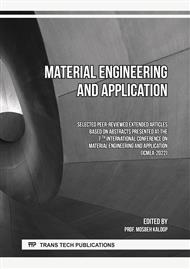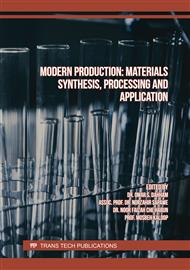[1]
T. Nishino, I. Matsuda, and K. Hirao, All-Cellulose Composite,, Macromolecules, 2004; 37(20): 7683–7687.
DOI: 10.1021/ma049300h
Google Scholar
[2]
T. Huber, S. Bickerton, J. Müssig, S. Pang, and M. P. Staiger, Solvent infusion processing of all-cellulose composite materials,, Carbohydr. Polym., 2012; 90(1): 730–733.
DOI: 10.1016/j.carbpol.2012.05.047
Google Scholar
[3]
F. Hafizulhaq, H. Abral, A. Kasim, S. Arief, and J. Affi, Moisture Absorption and Opacity of Starch-Based Biocomposites Reinforced with Cellulose Fiber from Bengkoang,, Fibers, 2018; 6(3): 62-73.
DOI: 10.3390/fib6030062
Google Scholar
[4]
B. Singh, M. Gupta, and A. Verma, Influence of fiber surface treatment on the properties of sisal-polyester composites,, Polym. Compos., 1996; 17(6): 910–918.
DOI: 10.1002/pc.10684
Google Scholar
[5]
M. P. W. A. Schirp, Influence of fungal decay and moisture absorption on mechanical properties of extruded wood-plastic composites,, Wood Fiber Sci., 2005; 37: 643–652.
Google Scholar
[6]
J. W. Dormanns, J. Schuermann, J. Müssig, B. J. C. Duchemin, and M. P. Staiger, Solvent infusion processing of all-cellulose composite laminates using an aqueous NaOH/urea solvent system,, Compos. Part A Appl. Sci. Manuf., 2016; 82: 130–140.
DOI: 10.1016/j.compositesa.2015.12.002
Google Scholar
[7]
T. Huber, J. Müssig, O. Curnow, S. Pang, S. Bickerton, and M. P. Staiger, A critical review of all-cellulose composites,, J. Mater. Sci., 2011; 47(3): 1171–1186.
DOI: 10.1007/s10853-011-5774-3
Google Scholar
[8]
B. J. C. Duchemin, A. P. Mathew, and K. Oksman, All-cellulose composites by partial dissolution in the ionic liquid 1-butyl-3-methylimidazolium chloride,, 2009; 40(12): 2031–(2037).
DOI: 10.1016/j.compositesa.2009.09.013
Google Scholar
[9]
A. Shakeri A, and M. P. Staiger, Phase transformations in regenerated microcrystalline cellulose following dissolution by an ionic liquid,, Bioresources, 2010; 5: 979–989.
Google Scholar
[10]
W. Gindl and J. Keckes, All-cellulose nanocomposite,, Polymer., 2005; 46(23): 10221–10225.
DOI: 10.1016/j.polymer.2005.08.040
Google Scholar
[11]
C. Qin, N. Soykeabkaew, N. Xiuyuan, and T. Peijs, The effect of fibre volume fraction and mercerization on the properties of all-cellulose composites,, Carbohydr. Polym., 2008; 71(3): 458–467.
DOI: 10.1016/j.carbpol.2007.06.019
Google Scholar
[12]
H. Yousefi, T. Nishino, M. Faezipour, and G. Ebrahimi, Direct Fabrication of all-Cellulose Nanocomposite from Cellulose Microfibers Using Ionic Liquid-Based Nanowelding,, Biomacromolecules, 2011; 12: 4080–4085.
DOI: 10.1021/bm201147a
Google Scholar
[13]
H. Yousefi, T. Nishino, A. Shakeri, M. Faezipour, G. Ebrahimi, and M. Kotera, Water-repellent all-cellulose nanocomposite using silane coupling treatment,, J. Adhes. Sci. Technol., 2013; 27(12): 1324–1334.
DOI: 10.1080/01694243.2012.695954
Google Scholar
[14]
Z. Yuan and Y. Wen, Enhancement of hydrophobicity of nanofibrillated cellulose through grafting of alkyl ketene dimer,, Cellulose, 2018; 25(12): 6863–6871.
DOI: 10.1007/s10570-018-2048-0
Google Scholar
[15]
K. B. Adhikary, S. Pang, and M. P. Staiger, Dimensional stability and mechanical behaviour of wood–plastic composites based on recycled and virgin high-density polyethylene (HDPE),, Compos. Part B Eng., 2008; 39(5): 807–815.
DOI: 10.1016/j.compositesb.2007.10.005
Google Scholar
[16]
A. A. Klyosov, Standard Test Method for Water Absorption of Plastics,, ASTM Int. Des. D 570 – 98, 2007; 16.
Google Scholar
[17]
P. Buahom, Measuring the Contact Angle using ImageJ with Contact Angle plug-in,, ResearchGate, (2018).
Google Scholar



